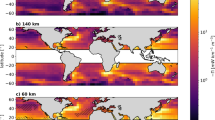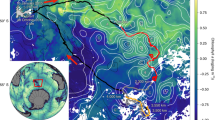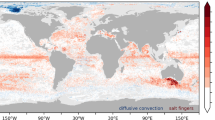Abstract
The thermohaline circulation of the ocean results primarily from downwelling at sites in the Nordic and Labrador Seas and upwelling throughout the rest of the ocean. The latter is often described as being due to breaking internal waves. Here we reconcile the difference between theoretical and observed estimates of vertical mixing in the deep ocean by presenting a revised view of the thermohaline circulation, which allows for additional upwelling in the Southern Ocean and the separation of the North Atlantic Deep Water cell from the Antarctic Bottom Water cell. The changes also mean that much less wind and tidal energy needs to be dissipated in the deep ocean than was originally thought.
Similar content being viewed by others
Main
Previous calculations of vertical mixing based on the stratification of the deep ocean1,2 assumed that a flux of 25 or 30 sverdrups (Sv) of water, made up of both deep and bottom waters, is injected at depths of about 4,000 metres and mixed upwards to depths near 1,000 m by turbulent mixing. Both reports conclude that the spatially averaged diapycnal (cross-density surface) mixing coefficient is 10−4 m2 s−1.
However, observations of turbulence3 and dye diffusion4 in the deep ocean indicate that there exists a background diapycnal diffusivity of only 10−5 m2 s−1, although much larger values are found in localized regions near rough topography5. The background value is consistent with mixing due to the background internal wave field, and the larger values are consistent with extra internal waves due to the interaction of currents with topography.
But it is not obvious that the latter is enough to raise diffusivity by an order of magnitude when averaged over the whole ocean. The extra power required to do this is also large6. If the efficiency is 20%, which is normally considered a maximum for the final stage of breaking internal waves, then the power required is 2.1 terawatts. This is just possible, given current estimates of the energy input from the wind and tides, but this figure does not allow for losses at other stages in the conversion process.
A contrasting view of the thermohaline circulation has come from low-resolution7 and high-resolution8 computer model studies of the ocean circulation. These show that between 9 and 12 Sv of deep water is brought to the surface by Ekman suction in the Southern Ocean. This is driven northwards in the surface Ekman layer and is reduced in density primarily by surface freshening. The model results also emphasize earlier observations9 that in the primary regions of bottom-water formation around Antarctica, the near-surface water masses have the same density as North Atlantic deep water. It is therefore not necessary for the bottom water to be mixed through the whole depth of the water column, only up to the level of the deep waters.
Using this new view of the thermohaline circulation, we need only consider the vertical mixing of the main deep-water mass, North Atlantic Deep Water, whose flux is estimated to lie between 14 and 17 Sv (ref. 10). Taking the larger of these two values and the smaller of the two model-based estimates of upwelling leaves a maximum of 8 Sv to be mixed vertically within the ocean. The 10−5 m2 s−1 background term can upwell 3 Sv, leaving 5 Sv to be upwelled by localized regions of intense mixing. If this view is correct, then the vertical mixing coefficient, averaged over the whole ocean, is less than 3 × 10−5 m2 s−1 and, assuming 20% efficiency, the total amount of extra energy required is less than 0.6 terawatts.
The revised values are consistent with existing observations of mixing within the ocean. They also emphasize again the importance of the Southern Ocean and imply that although further research is needed on the localized mixing in the deep ocean, such mixing does not control the thermohaline circulation.
References
Munk, W. H. Deep-Sea Res. 13, 707–730 (1966).
Munk, W. H. & Wunsch, C. Deep-Sea Res. 45, 1977–2010 (1998).
Gregg, M. C. J. Geophys. Res. 94, 9686–9698 (1989).
Ledwell, J. R., Watson, A. J. & Law, C. S. J. Geophys. Res. 103, 21499 –21529 (1998).
Polzin, K. et al. Science 276, 93–96 (1997).
Wunsch, C. Nature 405, 743–744 ( 2000).
Toggweiler, J. R. & Samuels, B. J. Phys. Oceanogr. 28, 1832–1852 ( 1998).
Döös, K. & Coward, A. C. Int. WOCE Newslett. 27, 3–4 (1997 ).
Foster, T. D. & Carmack, E. C. Deep-Sea Res. 23, 301–317 (1976).
Schmitz, W. J. Rev. Geophys. 33, 151–173 (1995).
Author information
Authors and Affiliations
Rights and permissions
About this article
Cite this article
Webb, D., Suginohara, N. Vertical mixing in the ocean. Nature 409, 37 (2001). https://doi.org/10.1038/35051171
Issue Date:
DOI: https://doi.org/10.1038/35051171
This article is cited by
-
Sulphur Isotopic Evidence for Upwelling of Anoxic Deep Water as the Cause of End-Permian Mass Extinction from Guryul Ravine Permo-Triassic Boundary Section, Kashmir, India
Journal of the Geological Society of India (2022)
-
Diagnostic evaluation of effects of vertical mixing on meridional overturning circulation in an idealized ocean
Journal of Oceanography (2021)
-
The use of tidally induced vertical-mixing schemes in simulating the Pacific deep-ocean state
Journal of Oceanography (2021)
-
Impact of deep ocean mixing on the climatic mean state in the Southern Ocean
Scientific Reports (2018)
-
Deep circulation driven by strong vertical mixing in the Timor Basin
Ocean Dynamics (2017)
Comments
By submitting a comment you agree to abide by our Terms and Community Guidelines. If you find something abusive or that does not comply with our terms or guidelines please flag it as inappropriate.



